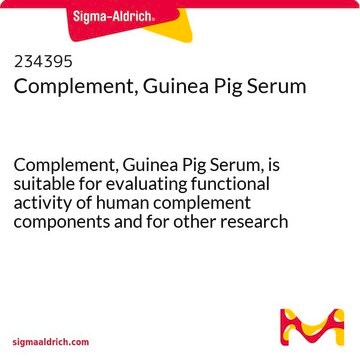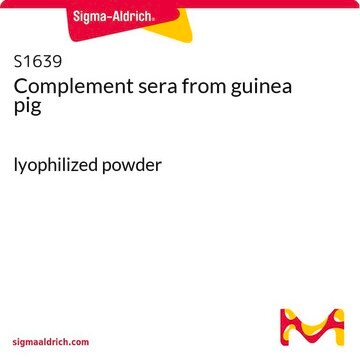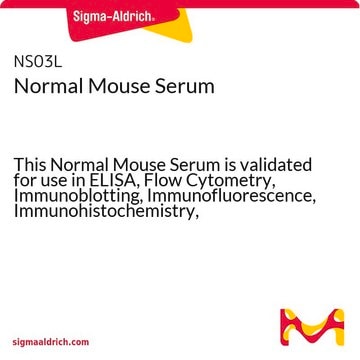M5774
Anti-Mouse Serum antibody produced in rabbit
whole antiserum
Sign Into View Organizational & Contract Pricing
All Photos(1)
About This Item
Recommended Products
biological source
rabbit
conjugate
unconjugated
antibody form
whole antiserum
antibody product type
primary antibodies
clone
polyclonal
contains
15 mM sodium azide
species reactivity
mouse
technique(s)
immunoelectrophoresis: suitable
shipped in
dry ice
storage temp.
−20°C
target post-translational modification
unmodified
General description
Mouse serum comprises hormones, antigens, electrolytes and antibodies. It serves blocking agent in immunoassays.
Specificity
Strong reactivity with normal mouse serum has been determined by immunoelectrophoresis (IEP). This antiserum has not been assayed for interspecies crossreactivity.
Application
Anti-Mouse Serum antibody produced in rabbit has been used in differential fluorescent labelling. It has also been used in differential staining of inner cell mass (ICM) and and trophectoderm (TE) cells. It has been also been used in the removal of zona pellucidae for the isolation of inner cell mass (ICM) from mouse blastocysts.
Anti-Mouse Serum antibody produced in rabbit was used as blocking agent in differential cell count of trophectoderm and inner cell mass cells of mouse embryos.
Physical form
Rabbit Anti-Mouse Serum is provided as a liquid containing 15 mM sodium azide as preservative.
Storage and Stability
For continuous use, store at 2-8 °C for up to one month. For extended storage, the solution may be frozen in working aliquots. Repeated freezing and thawing is not recommended. Storage in "frost-free" freezers not recommended. If slight turbidity occurs upon prolonged storage, clarify the solution by centrifugation before use.
Disclaimer
Unless otherwise stated in our catalog or other company documentation accompanying the product(s), our products are intended for research use only and are not to be used for any other purpose, which includes but is not limited to, unauthorized commercial uses, in vitro diagnostic uses, ex vivo or in vivo therapeutic uses or any type of consumption or application to humans or animals.
Not finding the right product?
Try our Product Selector Tool.
Storage Class Code
10 - Combustible liquids
WGK
WGK 3
Flash Point(F)
Not applicable
Flash Point(C)
Not applicable
Certificates of Analysis (COA)
Search for Certificates of Analysis (COA) by entering the products Lot/Batch Number. Lot and Batch Numbers can be found on a product’s label following the words ‘Lot’ or ‘Batch’.
Already Own This Product?
Find documentation for the products that you have recently purchased in the Document Library.
Carla Mulas et al.
Development (Cambridge, England), 146(6) (2019-03-28)
The power of mouse embryonic stem (ES) cells to colonise the developing embryo has revolutionised mammalian developmental genetics and stem cell research. This power is vulnerable, however, to the cell culture environment, deficiencies in which can lead to cellular heterogeneity
Raúl Fernández-González et al.
Reproduction (Cambridge, England), 137(2), 271-283 (2008-11-20)
We have reported that in vitro culture (IVC) of preimplantation mouse embryos in the presence of FCS produces long-term effects (LTE) on development, growth and behaviour of the offspring at adult age. To analyse the mechanisms underlying this phenomenon, we
Bi-ke Zhu et al.
Reproduction, nutrition, development, 44(3), 219-231 (2004-10-06)
This study was undertaken to investigate the effects of three media, volume and type of oil and frequency of observation on the in vitro development of mouse zygotes. B6CBF1 female mice (4 to 6 wk old) were superovulated using PMSG/hCG
Effects of partial or complete laser-assisted hatching on the hatching of mouse blastocysts and their cell numbers
Chailert C, et al.
Reproductive Biology and Endocrinology, 11(1), 21-21 (2013)
Usanee Sanmee et al.
Clinical and experimental reproductive medicine, 43(3), 152-156 (2016-10-01)
We studied the effect of the site of laser zona opening on the complete hatching of mouse blastocysts and the cell numbers of the completely hatched blastocysts. Mouse blastocysts were randomly allocated to the inner cell mass (ICM) group (zona
Our team of scientists has experience in all areas of research including Life Science, Material Science, Chemical Synthesis, Chromatography, Analytical and many others.
Contact Technical Service







